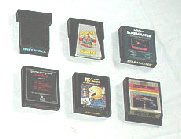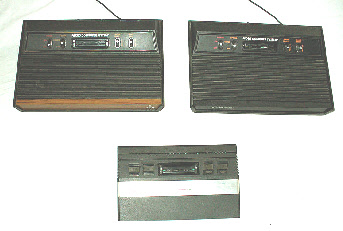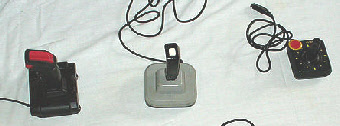
The console was the main part of the system and had all the switches you needed to select and play a game. It also had two difficulty switches, one for each player and a black and white switch. The difficulty switches were moved to the top back of the console and made into sliders . The difficulty switches do what they say and provide a harder or easier game. In a game like pong, the player on the harder difficulty would have a smaller paddle, other games had less enemies or allowed for a new life earlier. Each game controlled its own difficulty settings. Some games it made no difference. There was a power switch, that turned the consoles power on and off. It was needed often as whenever you wanted to change a cartridge, you had to turn the power off first. The Select switch let you go through the game variations, if any, included with the cartridge, this was generally represented by a number and the games manual would tell you what that version was. There was also a start reset switch that let you start the game you selected. To reset the console you could turn it off or just cycle though the variations back to the one you want.
The Black and White switch, when the Atari was introduced a lot of people still had black and white TV sets, the switch simply change the output from color a color output to a gray scale output. Later in its life the B/W switch was used to toggle game screens in games like Activiision’s Starmaster.
The Guts
Except for the consoles outer appearance all the Atari 2600 models internals were pretty much the same, with a few minor changes over the decades. The main console measured about 34 cm x 23 cm x 10 cm until the Jr. series when they shrunk to 27 cm x 16.5 cm x 4.5 cm. These numbers are a bit deceiving as the original 2600s had a raised panel at the back and the Jr.is a bit of a wedge shape.The Atari 2600’s internals are pretty basic by today's standards. It used a 6507(basically a cheap version of the 6502, could have been a 6502 in first series) CPU running at 1.19 MHz and a 6532 I/O and RAM controller chip that reads the console switches, the game controllers, contains the only RAM in the console and has a general purpose timer. The total RAM of an Atari 2600 is 128 bytes, extra could be added within the game cartridge itself. The game ROMs (cartridges) had a 4 kb maximum although more could be obtained through the use of bank switching. For graphics and sound the Atari 2600 used a custom chip known as TIA or Stella it had a 2 channel mono sound processes and could display a 128 colors in NTSC, 104 colors in PAL or 8 colors in SECAM at a resolution of 160 x 192 pixels. This custom chip not only took care of all sound and graphics functions including the synchronization of the TV signal, it also had registers for the joystick buttons. This chip ran at 2.58 MHz and its graphics clock matched the system clock speed at 1.19 MHz. Then there is the RF modulator that is often confused with the switch box, the RF modulator and its job was to convert the video game signal into a standard TV signal or channel. The first Atari worked only on channel 3 while the later ones were switchable between channel 3 and 4. The signal the RF modulator sent down the RCA cable to the TV is exactly the same as a regular TV station and is treated by the TV tuner like a regular TV channel would be. The switch box is really just what it says a switch in a box that allows more than one connection (antenna) to be hooked up to the same TV.
The switch box connected to the TVs antenna input and the Atari’s RCA cable plug
into it, as did the original antenna. To view the Atari signal you put the switch
to game, to view the TV signal you would switch it to TV. When the first Atari was
released this was the only way to connect it to a TV, as a TV did not have coaxial(cable),
composite(VCR\Modern console), s-
Back to the Atari 2600
When you bought an Atari 2600 it came complete with the console ,2 joysticks, one set of paddles, a power supply/plug, a tv switch box and the combat cartridge. You were ready to go without any extra expense. Of course you needed more games than combat like space invaders or adventure or one of 800 plus games that were available for the Atari 2600 system .There were the games that needed there own controllers like the keypads for Basic, and the Steering controllers for Grand Prix, of course you could have two sets of paddles for those 4 player paddle games like Casino, Blackjack and Video Olympics. There was also a track ball, a special Sesame Street Keypad, and a keypad for Star raiders. There were remote joysticks, Auto fire Joysticks, a Tron joystick and many other 3rd party joysticks and branded controllers. Some controllers came with games others you had to buy the controller separately. Looking back there were some simple mods, like attaching a switch to the joystick for rapid fire. Nothing really major like flipping chips although there have been a number of hacks since its demise.
The Console
There were a number of versions of the Atari VCS or 2600, the original had the simulated wood grain, and all six metal pole switches were on the front, know as a ‘sixer’. Then then moved ta few switches to the back and made them small sliders, these were the most common. There was an all black edition of this 4 switch Atari 2600 know as the Darth Vader model, although I do not believe there was any original affiliation between the console and the film Star Wars. Later the Atari Jr. appeared and introduced LEDs to the front of the console, and the switches became flat. It looked similar to an Atari 5200 console, all black with a silver bar and either a small rainbow or a long rainbow. There was also a solid black and solid white version of the unit, although they seem to be very rare. There were also a number of bootleg Atari 2600 models and a few licensed models like the famous Sears Telegames system.. If any one has the Mexican 128 in 1 Atari Jr please let me know.
The game cartridges
The game cartridge, contained a circuit board with a ROM chip that held the games programming, it may also have contained some extra RAM. When the consoles power was turned on power was supplied to the cartridge and the program became available to the system and was automatically executed. Without a cartridge the console was pretty much useless.




